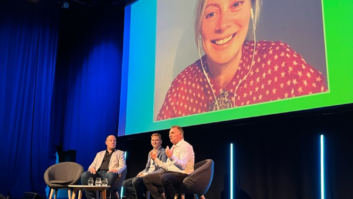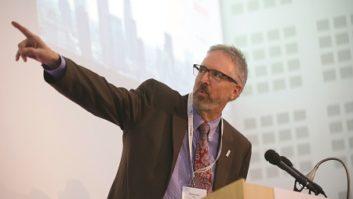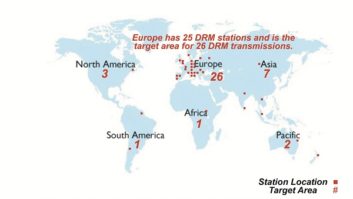
The Roberts Revival U.K. DAB receiver combined ‘50s retro
styling and British patriotism with modern DAB radio functionality.
Photo courtesy Roberts Radio LONDON — The United Kingdom has been a trailblazer and flag-bearer for digital audio broadcasting (DAB, DAB+). Both the BBC and private broadcasters have been offering DAB content on air since the 1990s. DAB radios have been heavily promoted here, and the U.K. government has thrown its weight behind switching off analog AM/FM in favor of digital DAB.
Apparently, their efforts have been paying off. According to Radio Joint Audience Research (RAJAR), the U.K.’s official measurer of radio audiences, 51 percent of U.K. adults 15+ listen to at least five minutes of radio each week via a digital platform; namely a DAB receiver, DTV or via the Web. This 2Q 2014 data was released July 31, 2014.
RESULTS
In 2Q 2014, U.K. listeners tuned in for an average of 378 million hours of digitally-delivered radios each week. “DAB radio is still the most popular device when it comes to listening digitally, accounting for 65 percent of all digital hours (24 percent of total hours),” said a July 31 graphic at www.rajar.co.uk detailing 2Q 2014 U.K. radio listening in general. “Listening via DTV (digital television) represents 13 percent (5 percent of total hours) and listening online 17 percent (6 percent of total hours) of all digital listening hours.”
So what is the place of digital and DAB vis-a-vis overall U.K. radio listenership? “The share of all radio listening via a digital platform now stands at 36.8 percent, the same as the corresponding period last year and slightly up on the previous quarter (36.6 percent in Q1, 2014),” RAJAR said. That’s up from 21.1 percent in 2009. “The share of listening to DAB has increased by 1 percent to 24.1 percent of all listening (23.9 percent in Q2, 2013).”
One last key fact: “48.5 percent claim to have a digital set at home; up from 41.7 percent in 2Q 2013,” reported RAJAR. That works out to 26 million U.K. residents 15+, out of a total 15+ population of 54.6 million; 48.1 million who tune into U.K. radio every week.

The Pure Evoke 2S combines stereo DAB with
classic wooden radio design. Photo courtesy PURE Clearly, DAB has made significant inroads into the U.K. market — but not enough yet to prod the country’s government into setting a firm DAB switchover/analog transmission shutdown date. The reason: Based on the government’s Digital Radio Action Plan, a switchover will not happen until “50 percent of all listening is to digital; and national DAB coverage is comparable to FM, and local DAB reaches 90 percent of the population and all major roads,” says version 10 of the Digital Radio Action Plan, which was issued on Jan. 9, 2014.
Other benchmarks established by the government — DAB coverage being equivalent to FM for all stations that need to switchover to DAB, and more cars having DAB receivers (55 percent of new U.K. cars come with standard DAB radios) have yet to be achieved.
Against this backdrop, the minister responsible for U.K. broadcasting — Ed Vaizey, minister for Culture, Communications and Creative Industries — has been noncommital about setting a DAB switchover date. “I have always said that the radio listener will lead the transition to digital,” Vaizey said in a December 2013 speech. Based on the benchmarks his government has put in place, “We are not there yet. So now is not the time to switchover.”
The most the U.K. government has committed to is reviewing the possibility of setting a DAB switchover date at the end of 2014. One can almost hear Sir Humphrey Appleby (arch-bureaucrat of the “Yes, Minister” TV series) intoning, “at the appropriate juncture, in due course, in the fullness of time.”

The Roberts iDream 200 combines an iPod connection
with a DAB clock radio. Photo courtesy Roberts Radio
AM/FM STILL A FACTOR
Compared to other nations, the U.K. has been tremendously successful in promoting DAB to the listening public. In Canada, for sake of contrast, attempts to launch DAB since the 1990s have fallen not just flat, but utterly failed.
Attempts to popularize DAB in the 1452–1492 MHz L Band went so poorly — notably due to a lack of affordable receivers — that the service was officially terminated in 2012. This despite DAB simulcasts of Canadian AM/FM stations being widely available in the country’s major markets. Canada is now said to be considering adopting the U.S. HD Radio model.
One factor that is affecting the DAB rollout is its pre-Internet roots. It was conceived before the advent of the Internet, streaming media and wireless broadband. The impact of this fact is noted in RAJAR’s 2Q 2014 report: 22 percent of adults “claim to listen to the radio via a mobile phone or tablet at least once per month,” up 51 percent over 2Q 2013.
Meanwhile, RAJAR’s data shows that analog AM/FM remains the most popular source of radio listening at 56.6 percent; down from 58.6 percent a year earlier. Moreover, “66.6 percent of new radio receivers purchased in the U.K. are analog and cannot receive DAB,” said Grant Goddard, a London-based media analyst specializing in radio. Goddard recently researched and authored a report for a commercial radio group on the issues surrounding the proposed DAB switchover.
That’s just the beginning of the DAB issues Goddard’s research discovered: “U.K. unit sales of DAB radio receivers peaked in 2008 and have since been in decline,” he said. “The average retail price of a portable DAB radio receiver is three times that of a portable analog radio receiver, and only 19 percent of radio users are likely to buy a DAB radio receiver in the next 12 months.” This may also explain why listening to digital radio via smartphone/tablet is rising so fast in the U.K.: Why buy a new DAB receiver when you can get the content on your existing smartphone/tablet for free?
All told, Goddard is not convinced that the growth in digital radio listenership is sufficient to push the U.K. government to set a firm switchover date. In fact, “The U.K. government’s statement in December 2013 kicked its policy of mandatory DAB radio switchover into the long grass, never to be revisited,” he said.
INEVITABLE CHANGE
The fact that the DAB rollout is taking time does not change the fact that the medium is making serious progress, said Jane Ostler, communications director for Digital Radio UK, the industry/government body leading the U.K.’s DAB campaign.
Driving this growth is continued technological progress. “We’re about to build a second commercial DAB multiplex, to bring even more AM/FM stations onto DAB,” Ostler said. “And while more of the U.K.’s 30 million cars are replaced — about two million are scrapped annually — more cars on the road will be equipped with DAB receivers, until virtually all of them are.”
Unlike Goddard, Ostler does not believe the DAB digital switchover question has been “kicked into the long grass, never to be revisited.” Instead, she expects that “the next two to three years will be crucial in terms of the medium’s progress, and the government’s ability to decide upon a firm switchover date based on meeting their 50 percent criteria,” she said.
In the end, it may be the preponderance of DAB receivers in cars as standard equipment that pushes U.K. DAB over the top; given the public’s preference for buying cheaper AM/FM radios when given the choice. When and if this preponderance occurs is an open question, which is why setting a date for a U.K. DAB switchover is an open question — both for the country’s politicians, and broadcasters as well.
James Careless reports on the industry for Radio World from Ottawa, Ontario.











